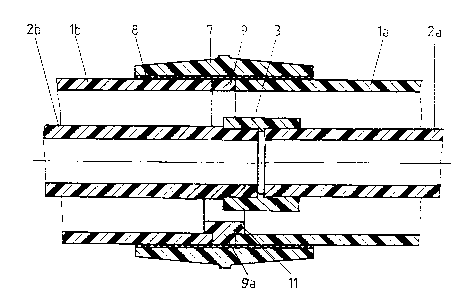Une partie des informations de ce site Web a été fournie par des sources externes. Le gouvernement du Canada n'assume aucune responsabilité concernant la précision, l'actualité ou la fiabilité des informations fournies par les sources externes. Les utilisateurs qui désirent employer cette information devraient consulter directement la source des informations. Le contenu fourni par les sources externes n'est pas assujetti aux exigences sur les langues officielles, la protection des renseignements personnels et l'accessibilité.
L'apparition de différences dans le texte et l'image des Revendications et de l'Abrégé dépend du moment auquel le document est publié. Les textes des Revendications et de l'Abrégé sont affichés :
| (12) Brevet: | (11) CA 2020414 |
|---|---|
| (54) Titre français: | METHODE DE RACCORDEMENT DE TUYAUX EN MATIERES PLASTIQUES POUR RESEAU A DOUBLE TUYAU ET CONNEXION AINSI REALISEE |
| (54) Titre anglais: | METHOD OF CONNECTING PIPES OF PLASTICS MATERIAL OF A DOUBLE PIPE SYSTEM AND A PIPE CONNECTION MADE BY THE METHOD |
| Statut: | Périmé et au-delà du délai pour l’annulation |
| (51) Classification internationale des brevets (CIB): |
|
|---|---|
| (72) Inventeurs : |
|
| (73) Titulaires : |
|
| (71) Demandeurs : |
|
| (74) Agent: | ROBIC AGENCE PI S.E.C./ROBIC IP AGENCY LP |
| (74) Co-agent: | |
| (45) Délivré: | 1996-03-19 |
| (22) Date de dépôt: | 1990-07-04 |
| (41) Mise à la disponibilité du public: | 1991-01-08 |
| Requête d'examen: | 1993-11-18 |
| Licence disponible: | S.O. |
| Cédé au domaine public: | S.O. |
| (25) Langue des documents déposés: | Anglais |
| Traité de coopération en matière de brevets (PCT): | Non |
|---|
| (30) Données de priorité de la demande: | ||||||
|---|---|---|---|---|---|---|
|
A method of connecting pipes of plastics material of a
double pipe system and a pipe connection made by the method.
The inner pipes of the pipe system are connected to each
other with a sleeve member by welding or gluing. Clamping
jaws are used for holding and moving the inner pipes toward
each other. The outer pipes are shorter than the inner pipes
at least by the thickness of the two clamping jaws. For
bridging the gap between the outer pipes, an expandable
intermediate ring is inserted in the gap. An electric
welding sleeve is used for connecting the outer pipes and the
intermediate ring.
Note : Les revendications sont présentées dans la langue officielle dans laquelle elles ont été soumises.
Note : Les descriptions sont présentées dans la langue officielle dans laquelle elles ont été soumises.

2024-08-01 : Dans le cadre de la transition vers les Brevets de nouvelle génération (BNG), la base de données sur les brevets canadiens (BDBC) contient désormais un Historique d'événement plus détaillé, qui reproduit le Journal des événements de notre nouvelle solution interne.
Veuillez noter que les événements débutant par « Inactive : » se réfèrent à des événements qui ne sont plus utilisés dans notre nouvelle solution interne.
Pour une meilleure compréhension de l'état de la demande ou brevet qui figure sur cette page, la rubrique Mise en garde , et les descriptions de Brevet , Historique d'événement , Taxes périodiques et Historique des paiements devraient être consultées.
| Description | Date |
|---|---|
| Inactive : CIB de MCD | 2006-03-11 |
| Inactive : CIB de MCD | 2006-03-11 |
| Inactive : CIB de MCD | 2006-03-11 |
| Le délai pour l'annulation est expiré | 2001-07-04 |
| Lettre envoyée | 2000-07-04 |
| Accordé par délivrance | 1996-03-19 |
| Exigences pour une requête d'examen - jugée conforme | 1993-11-18 |
| Toutes les exigences pour l'examen - jugée conforme | 1993-11-18 |
| Demande publiée (accessible au public) | 1991-01-08 |
Il n'y a pas d'historique d'abandonnement
| Type de taxes | Anniversaire | Échéance | Date payée |
|---|---|---|---|
| TM (brevet, 7e anniv.) - générale | 1997-07-04 | 1997-06-23 | |
| TM (brevet, 8e anniv.) - générale | 1998-07-06 | 1998-06-19 | |
| TM (brevet, 9e anniv.) - générale | 1999-07-05 | 1999-06-17 |
Les titulaires actuels et antérieures au dossier sont affichés en ordre alphabétique.
| Titulaires actuels au dossier |
|---|
| GEORG FISCHER AG |
| Titulaires antérieures au dossier |
|---|
| JORG WERMELINGER |